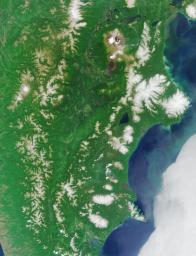The answers to this quiz appear in blue below each question.
1. Averaged over the entire geographic area of the region, which is larger?
(A) The average number of people per square kilometer.
(B) The average number of volcanoes per 1000 square kilometers.
Answer: A
The size of the Kamchatka Peninsula is around 472,000 square kilometres,
and the population is around 460,000, so the average number of people
per square kilometer is almost 1. There are an estimated 329 volcanoes
within this area, or about 0.70 volcanoes per 1000 kilometers.
2. Which is closer to the image area?
(A) The nearest point along the path of annularity of the first solar
eclipse of 2003.
(B) The location where a cargo ship spilled tens of thousands of
bathtub toys during rough seas in the early 1990s.
Answer: B
At its closest point to Kamchatka the path of the annular solar eclipse of
May 2003 was over 4000 kilometers away, off of Greenland’s western
coast. The toys were spilled into the North Pacific Ocean near the
International Date Line, about 1600 kilometers from Kamchatka.
3. Which is smaller?
(A) The population of the region at the beginning of the 18th century.
(B) The population of the region at the beginning of the 20th century.
Answer: B
At the start of the 18th century the local native population of Kamchatka
was about 20,000. The indigenous population was reduced to about 8000
by the mid-18th century. At the start of the 20th century the number of
Russian migrants was about 2500 and the indigenous population was
about 5000.
4. Which occurred earlier?
(A) Completion of a monument commemorating the seafarer who
founded what is now the regional capital city.
(B) The attack on the port of the city and defense of the port by a
44-gun frigate.
Answer: A
A monument to the famous explorer Vitus Bering, believed to be
oldest monument in the Russian Far East, was crafted in St.
Petersburg between 1823 and 1826 and now stands in
Petropavlovsk, near the harbour from which Bering started
his expedition to America. The defense of Petropavlosk by
the 44-gun frigate, the Aurora, occurred during the British-French
attack of 1854. (Note: A monument to Vitus Bering (circa 1966)
also exists on Bering Island in the Aleutians.)
5. Which is smaller?
(A) The number of masts of the ship upon which the aforementioned
seafarer sailed during the last voyage of his or her lifetime.
(B) The number of animals first identified and named after the naturalist
who sailed with the seafarer.
Answer: A
In 1741 naturalist Georg Wilhelm Steller set sail on the St. Peter,
with Vitus Bering on the journey to find the Alaskan coast. The St.
Peter was a single-deck two-mast ship. During the voyage, Steller
identified the now-extinct Steller's sea cow and the spectacled
cormorant, and described many other Alaskan species, including
Steller's sea lion, Steller's jay, Steller's sea-eagle, and the northern fur seal.
6. Within the region, which is further north?
(A) The main military base.
(B) The most important lake-environment spawning ground for
anadromous fish.
Answer: A
Rybachiy military base is located at the next major inlet south from
Avacha Bay/Petropavlovsk. The rivers and lakes of Kamchatka
are renowned for incredibly abundant fish and animal life. Kurilskoye
Lake (or Kuril Lake), is considered to be the largest lake-environment
spawning ground for sockeye (red) salmon in Asia, and is located at
the far southern tip of Kamchatka.
MISR was built and is managed by NASA's Jet Propulsion Laboratory,
Pasadena, CA, for NASA's Office of Earth Science, Washington, DC. The
Terra satellite is managed by NASA's Goddard Space Flight Center,
Greenbelt, MD. JPL is a division of the California Institute of
Technology.

 Planetary Data System
Planetary Data System












